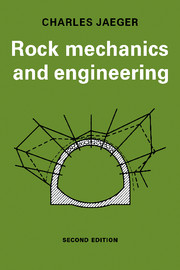Book contents
- Frontmatter
- Contents
- Preface
- Preface to the first edition
- Part 1 Introduction to rock mechanics
- Part 2 Rock material and rock masses
- Part 3 Rock mechanics and engineering
- 9 Rock slopes and rock slides
- 10 Galleries, tunnels, mines and underground excavations
- 11 Rock mechanics and dam foundations
- Part 4 Case histories
- References
- Appendix 1 Comments on the bibliography
- Appendix 2 Measurement conversion tables
- Appendix 3 Table of geological formations and earth history
- Appendix 4 Some petrographic properties of rocks
- Author Index
- Index of geographical names, dam sites, reservoirs, tunnels and caverns
- Subject Index
11 - Rock mechanics and dam foundations
Published online by Cambridge University Press: 04 August 2010
- Frontmatter
- Contents
- Preface
- Preface to the first edition
- Part 1 Introduction to rock mechanics
- Part 2 Rock material and rock masses
- Part 3 Rock mechanics and engineering
- 9 Rock slopes and rock slides
- 10 Galleries, tunnels, mines and underground excavations
- 11 Rock mechanics and dam foundations
- Part 4 Case histories
- References
- Appendix 1 Comments on the bibliography
- Appendix 2 Measurement conversion tables
- Appendix 3 Table of geological formations and earth history
- Appendix 4 Some petrographic properties of rocks
- Author Index
- Index of geographical names, dam sites, reservoirs, tunnels and caverns
- Subject Index
Summary
The classical approach to dam foundations
Some remains of very early dams have been found in Egypt, built by the pharaohs for irrigation. Some of them were pervious and could not have stored much water, others might have been washed away by floods. The oldest known arch dam ever to be built was discovered in 1956 by the French engineer Henri Goblot near Kebar, 150 km from Teheran. Some Spanish and French dams still stand (Alamansa, Elche, etc).
Several early dams failed. Others were built on pervious rock like Camarasa and Monte Jaque in Spain, and required expensive repair work to stop the leakages. Between 1910 and 1930 basic rules and techniques were developed for the safe design and construction of dams. They can be summarized as follows:
(1) check the imperviousness of the storage reservoir;
(2) check percolation conditions under the dam foundations and round the abutments;
(3) calculate gravity dams and buttress dams, including uplift and check the shear strength of the rock foundations;
(4) calculate arch dams and check compression and shear stresses along the periphery of the foundations.
In recent times these methods have been improved. The elasticity of the foundations is now included in the estimate of the total deformation of the dam, and more sophisticated methods are used to establish the curvatures of the shell forming the dam (Jaeger, 1958–64). But despite these improvements and the excellent quality of the concrete used on site, and the improved grouting techniques, tragic dam failures still occur (Gruner, 1963; Mary, 1968).
Information
- Type
- Chapter
- Information
- Rock Mechanics and Engineering , pp. 325 - 358Publisher: Cambridge University PressPrint publication year: 1979
